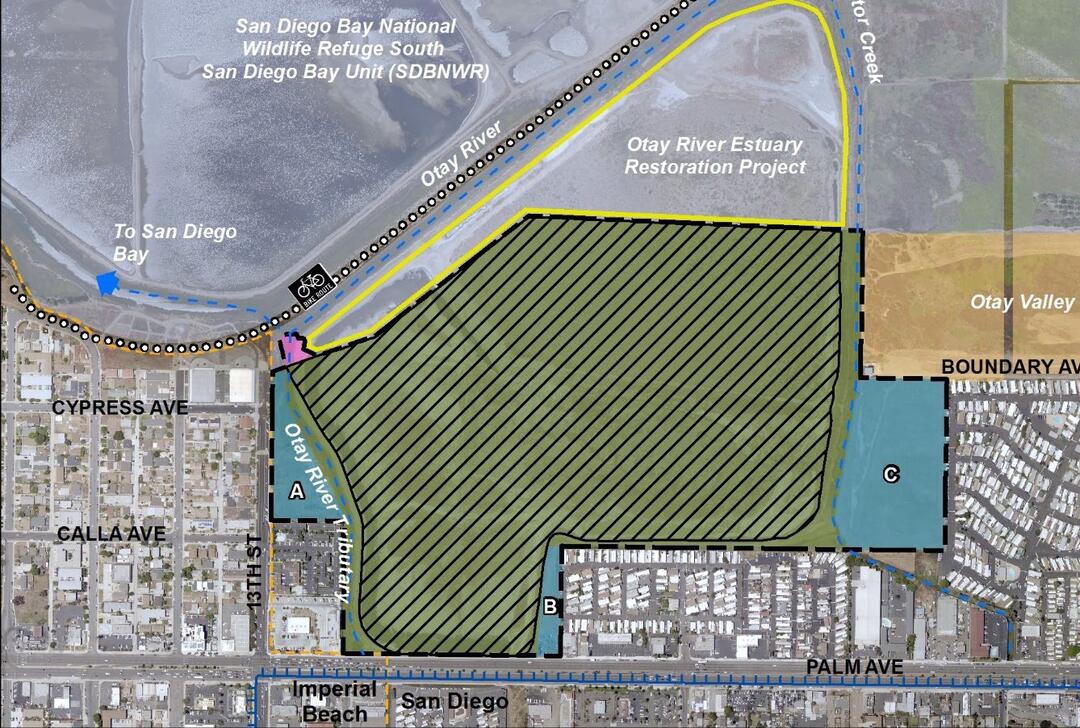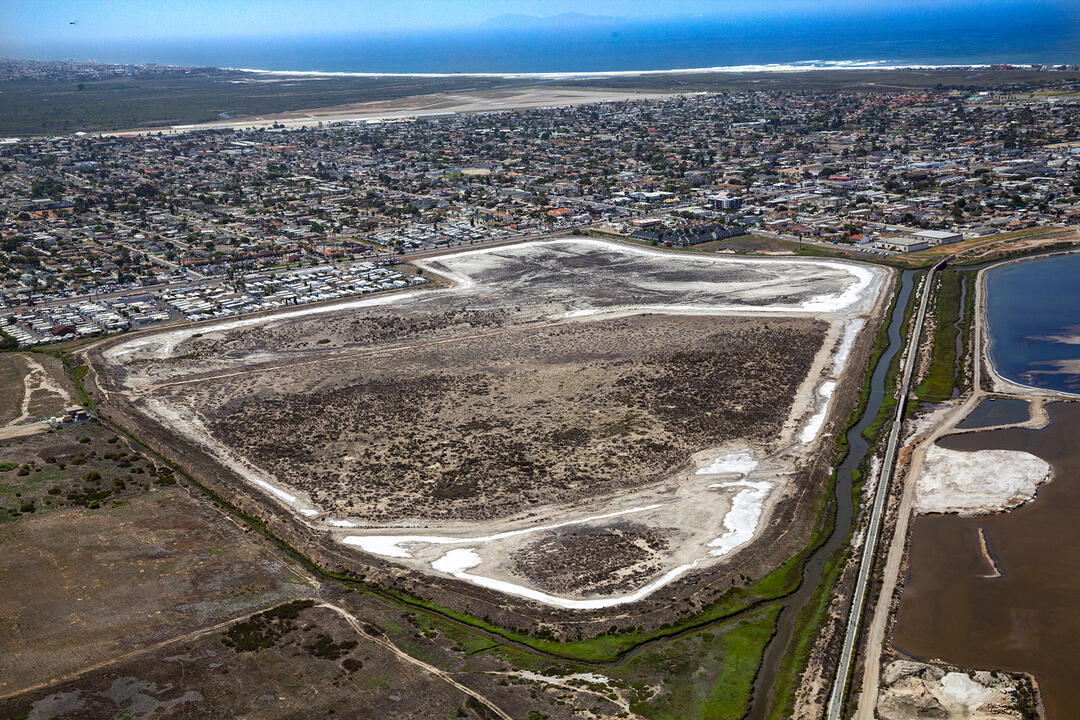Wetland Mitigation Bank at Pond 20
The Port of San Diego is proposing to construct 76.5 acres of coastal wetland habitat at Pond 20 to create a mitigation bank, the first of its kind for San Diego Bay. Pond 20, a former salt evaporation pond in south San Diego Bay, is currently vacant, isolated from tidal influence, and provides little habitat value due to its salt-encrusted surface and invasive plants. The wetland mitigation bank at Pond 20 would be a future catalyst supporting valuable ecosystem services such as protection from storm surges and erosion, increased biodiversity, improved water quality, increased carbon sequestration capacity, and more, while also providing pathways for additional wetland mitigation banks.
With this project, the Port is enhancing and investing in the South Bay – and it will be a win-win-win. A win for the environment, a win for the adjacent communities, and a win for the regional economy.
Environmental, Community, and
Regional Economic Benefits
Environmental benefits include creating new wetland systems in Southern California (wetlands are among the most productive ecosystems in the world; however, Southern California has lost an estimated 62 percent of its coastal wetlands, and much of the remaining wetlands are significantly degraded); increased biodiversity; providing food, habitat, and spawning grounds to fish, including recreational and commercial fish species; supporting migratory bird species and a suite of coastal wetland-dependent species; improved water quality; increased carbon sequestration capacity; and providing pathways for additional wetland mitigation banks.
Community benefits include protection from storm surge and sea level rise brought on by climate change and the resulting coastal erosion. For the thousands of residents and visitors who use the Bayshore Bikeway each week, the wildlife it attracts will be easily visible, providing an opportunity to promote multiple conservation priorities that are relevant to San Diego Bay, including educational opportunities (such as nature-viewing and educational signage). Additionally, the wetland mitigation bank will diversify and strengthen the Port's portfolio by creating a revenue source the Port can invest back into the community (the Port doesn't collect taxes) Once the mitigation bank begins to generate net revenue, those revenues will go toward future public improvement projects and maintenance around the bayfront, with these funds specifically directed for future economic development and public improvement projects in the adjacent Imperial Beach and San Diego communities.
Regional economic benefits include development mitigation - compensatory credits generated are anticipated to be available to mitigate for development impacts primarily within the San Diego, and possibly other coastal areas in Southern California and related watersheds. Sold credits would be used to recover the cost of development of the wetlands.

Next Steps
On April 13, 2021, the Board of Port Commissioners certified the Environmental Impact Report (EIR) and approved a Port Master Plan Amendment (PMPA) for the project. The next steps are as follows (anticipated timeline):
- 2021-2025: Processing the PMPA with the California Coastal Commission.
- 2022-2025:
- Preparation of a Banking and Enabling Instrument to establish the mitigation bank.
- Construction design changes based on preliminary feedback from resource agencies and wetlands avoidance.
2023: Soil removal in Parcel B complete.
- 2023:
- Soil removal in Parcel B complete.
- Construction began on northern portion of Pond 20 by Channelside (on USFWS Refuge property, not as part of the Port’s proposed wetland mitigation bank). This construction is anticipated to be completed by 2025.
- 2024: Coordination with the City of Imperial Beach for future beneficial reuse of soil from Pond 20 for placement on the beach. Evaluating other soil placement options within the Coastal Zone. 2025:
- Submit next draft of the Banking and Enabling Instrument to an Interagency Review Team. Once the Banking and Enabling Instrument is final and signed by all parties, the mitigation bank can release some credits.
- Potential PMPA certification anticipated from California Coastal Commission (pending ongoing discussions). If certified, Board of Commissioners would then consider acceptance of the Coastal Commission’s PMPA certification, then PMPA would go back once more to the Coastal Commission for final acceptance.
- 2026: Permit applications finalized with various state and federal agencies.
- 2027: Anticipated construction of wetlands mitigation bank (17-month construction schedule).
Pond 20 Timeline
The Board of Port Commissioners adopts a Memorandum of Understanding (MOU) between the Port and the cities of San Diego and Imperial Beach to explore uses for Pond 20.
The Port conducts public workshops and outreach meetings, and collects letters of interest, to receive input and feedback for ideas for potential projects for Pond 20.
The Port releases conceptual designs to the public for an artistic fence to replace a chain-link fence around Pond 20 and solicits public feedback via email.
The Port begins installation of the artistic fence.
The Port celebrates the completion of Pond 20’s artistic fence.
The Board:
- Directs the study of a land-use plan for the 95 acres of Pond 20 that will benefit Imperial Beach, the City of San Diego, and our entire region.
- Directs staff to issue a Request for Proposals (RFP) for mitigation banking for the Port or a developer to create a mitigation bank.
- Votes to establish the “Pond 20 Economic Development Fund”.
The Port issues an RFP seeking qualified consultants and/or developers to establish a wetlands mitigation bank at Pond 20.
By Resolution 2015-151, the Board adopts BPC Policy No. 774, the Pond 20 Economic Development Fund. Pursuant to Board Policy 774, certain funds from mitigation banking on Pond 20 will be deposited into a Pond 20 Economic Development Fund for potential future projects to be approved by the Board of Port Commissioners which are consistent with the Port Act.
The Board directs staff to conduct additional due diligence, which includes a review of the long-term maintenance and protection of a mitigation bank and related agency approvals, market analysis of current demand for mitigation credits, and refined cost estimates including the use of excess soil generated from the mitigation bank for use on other Port projects.
A Mitigation Ad-Hoc Committee is formed to continue the due diligence efforts and to validate assumptions that a mitigation bank would be successful at Pond 20. The Committee meets on three occasions to evaluate the strengths, risks, and uncertainties associated with creating a mitigation bank.
The Board authorizes an agreement with Great Ecology for $640,220 to prepare drawings and mitigation banking documents for a mitigation bank at Pond 20. Additionally, the Board approves commencing environmental and California Coastal Act review for Pond 20 and the two adjacent development parcels.
Port staff informed the Board that environmental review was underway and that the baseline study maps, jurisdictional wetlands delineation, functional assessment methodology, preliminary design, and Bank Prospectus were completed and had been submitted to the ACOE.
- The Army Corps of Engineers (ACOE) issued a jurisdiction determination for Pond 20, confirming that no Waters of the U.S. are present within the bermed area of Pond 20, and therefore are not regulated under Clean Water Act Section 404 (January 2021).
- The Board certified the Environmental Impact Report (EIR) for the proposed Wetland Mitigation Bank at Pond 20 and three adjacent parcels and approved an associated Port Master Plan Amendment (PMPA) for the proposed Wetland Mitigation Bank at Pond 20 (April 13, 2021).
- Port Master Plan Amendment submitted to the California Coastal Commission (June 2021).
- Permitting and entitlements, design and engineering, and coordination of Bank Enabling Instrument to continue.
Frequently Asked Questions
What was Pond 20 before the Port bought it?
The project site historically supported wetland habitats until at least 1870, when salt evaporation and extraction industry began operations in south San Diego Bay. The Western Salt Company (WSC) acquired the project site in the 1890s and created a large complex of networked condensation and crystallization salt evaporation ponds in south San Diego Bay. Berms were constructed around Pond 20, and a thick impermeable clay layer was placed to hold water and prevent leaching of water from the pond. The berms and thick clay layer are largely intact today. While the South Bay Salt Works still operates in south San Diego Bay, Pond 20 has not been utilized as an evaporation pond since the 1960s. The high elevation, inland location, and distance from other ponds made Pond 20 logistically and economically inefficient due to the increasing cost to pump water.
The Port purchased the project site in 1998 from WSC as part of a 1,400-acre land acquisition. The majority of the purchase was transferred to the California State Lands Commission to satisfy mitigation requirements for the expansion of Terminal 2 at the San Diego International Airport. The State Lands Commission subsequently entered into a 49-year lease, with an option to automatically extend for an additional 66 years, with the U.S. Fish & Wildlife Service (USFWS) to create the South San Diego Bay National Wildlife Refuge (NWR or Refuge). However, effective January 1, 2020, the Refuge was transferred to the Port per Senate Bill (SB) 507, which granted and conveyed in trust to the Port all rights, title, and interest in certain tidelands and submerged lands, as enumerated in SB 507. After the San Diego County Regional Airport Authority became a separate agency from the Port in 2003, the Port retained ownership rights to the Project Site, as provided in the SB 1896 (2002), with the intent of utilizing the Project Site, as well as the adjacent Parcels A (approximately 2.7 acres), B (approximately one acre), and C (approximately eight acres), for future development, subject to consistency with the Public Trust Doctrine.
Pond 20 Stats
90+years of industrial salt extraction (1870s to 1960s)
95acres
1998year the Port purchased the site

Port Projects

Waterfront Development
The National City Bayfront is made up of 273 acres of waterfront land and 167 acres of water and includes the National City Marine Terminal, Pepper Park, Pier 32 Marina, the Aquatic Center and many pieces of valuable public art. The National City…

The Port of San Diego is seeking community input to inform the design of the next phase of improvements to the park, specifically the southeastern waterfront area of César Chávez Park, as part of ongoing efforts to enhance the community experience…

Maritime
The Port’s maritime businesses are our gateway to the world, leading our working waterfront and facilitating the movement of goods and people, internationally and domestically. To support our cargo business, the Port of San Diego is making…

